The vaccine stabilizers market is projected to grow from USD 102.3 million in 2025 to approximately USD 168.2 million by 2035, recording an absolute increase of USD 65.9 million over the forecast period. This translates into a total growth of 64.4%, with the market forecast to expand at a compound annual growth rate (CAGR) of 5.1% between 2025 and 2035. The overall market size is expected to grow by nearly 1.64X during the same period, supported by increasing global vaccine development programs, growing demand for vaccine stability and efficacy, and rising adoption of advanced stabilization technologies in critical applications across global pharmaceutical and healthcare industries.
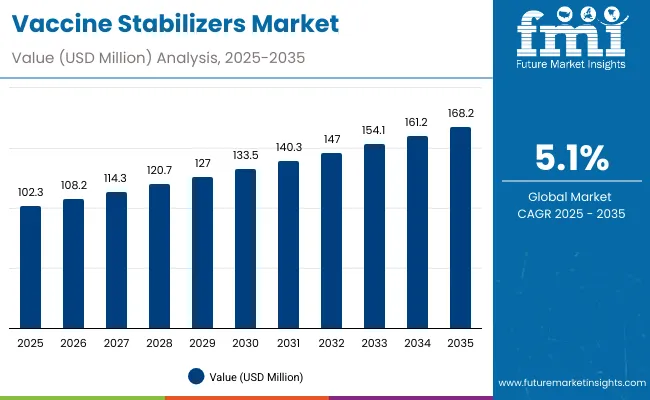
Vaccine Stabilizers Market Key Takeaways
| Metric | Value |
|---|---|
| Estimated Value in (2025E) | USD 102.3 million |
| Forecast Value in (2035F) | USD 168.2 million |
| Forecast CAGR (2025 to 2035) | 5.1% |
Between 2025 and 2030, the vaccine stabilizers market is projected to expand from USD 102.3 million to USD 131.2 million, resulting in a value increase of USD 28.9 million, which represents 43.9% of the total forecast growth for the decade. This phase of development will be shaped by increasing global vaccine manufacturing initiatives, rising adoption of advanced stabilization technologies, and growing utilization in subunit and inactivated vaccine applications. Pharmaceutical manufacturers and stabilizer suppliers are expanding their production capabilities to address the growing preference for effective and reliable stabilization solutions in critical vaccine manufacturing operations and specialty pharmaceutical applications.
From 2030 to 2035, the market is forecast to grow from USD 131.2 million to USD 168.2 million, adding another USD 37.0 million, which constitutes 56.1% of the overall ten-year expansion. This period is expected to be characterized by the expansion of advanced stabilization technologies, the integration of novel excipient systems with enhanced stability capabilities, and the development of specialized stabilizer solutions for emerging vaccine applications. The growing emphasis on vaccine stability and global immunization programs will drive demand for innovative stabilizer systems with enhanced protective properties and improved shelf life characteristics.
Between 2020 and 2024, the vaccine stabilizers market experienced robust growth, driven by increasing global vaccine development programs and growing recognition of stabilizers' importance in vaccine integrity and efficacy. The market developed as manufacturers recognized the potential for advanced stabilizers to enhance vaccine shelf life and potency while meeting stringent regulatory requirements. Technological advancement in stabilizer formulation and testing methods began emphasizing the critical importance of maintaining vaccine stability while extending storage capabilities and improving distribution characteristics.
Market expansion is being supported by the increasing global demand for stable and effective vaccines and the corresponding shift toward advanced stabilization technologies that can provide superior protection while meeting stringent quality specifications for critical pharmaceutical applications. Modern pharmaceutical facilities and vaccine manufacturers are increasingly focused on incorporating high-quality stabilizers to enhance vaccine stability while satisfying demands for extended shelf life and proven performance in demanding storage and distribution environments. Vaccine stabilizers' proven ability to deliver superior protection efficacy, operational reliability, and stability performance makes them essential components for advanced vaccine operations and critical pharmaceutical applications.
The growing emphasis on global vaccine accessibility and pandemic preparedness is driving demand for high-quality stabilizer systems that can support distinctive stability characteristics and temperature-critical applications across subunit, inactivated, and live attenuated vaccine categories. Manufacturer preference for excipients that combine protective excellence with proven stability credentials is creating opportunities for innovative stabilizer implementations in both traditional and emerging vaccine applications. The rising influence of regulatory requirements and vaccine distribution challenges is also contributing to increased adoption of advanced stabilizer systems that can provide effective protection while meeting stringent storage and transport requirements.
The market is segmented by vaccine type, excipient type, end user, and region. By vaccine type, the market is divided into live attenuated, inactivated, subunit, toxoid, and others. Based on excipient type, the market is categorized into amino acids, sugars, polymers, surfactants, and others. By end user, the market includes vaccine manufacturers, CMOs-CDMOs, academic & research institutes, government & public health labs, and other end users. Regionally, the market is divided into North America, Europe, Asia Pacific, Latin America, and Middle East & Africa.
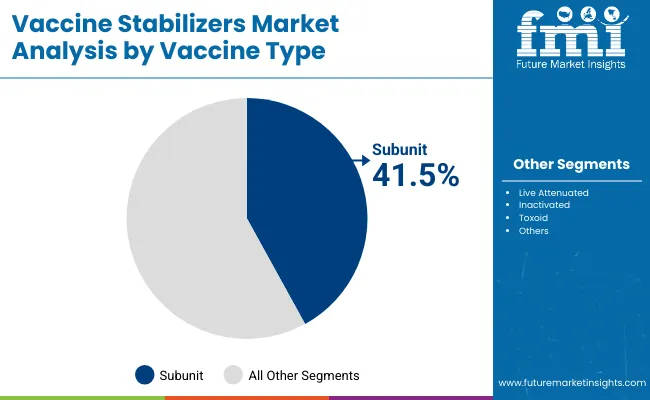
The subunit vaccines segment is projected to account for 41.5% of the vaccine stabilizers market in 2025, reaffirming its position as the leading vaccine type category. Pharmaceutical manufacturers and vaccine producers increasingly utilize subunit vaccine technologies for their enhanced safety profiles, targeted immune responses, and reduced side effect characteristics across diverse therapeutic applications. This vaccine type's proven design directly addresses immunization requirements for reliable efficacy and efficient production in high-volume applications.
This segment forms the foundation of modern vaccine stabilizer applications, as it represents the configuration with the greatest stability requirements and established compatibility across multiple vaccine formulations. Manufacturer investments in stabilization optimization and formulation enhancement continue to strengthen adoption among vaccine producers. With pharmaceutical companies prioritizing vaccine safety and consistent efficacy characteristics, subunit vaccines align with both therapeutic objectives and regulatory requirements, making them the central component of comprehensive vaccine stabilization strategies.
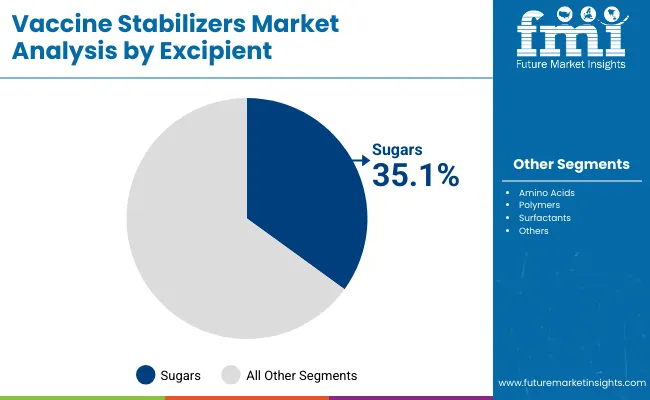
Sugars represent the dominant segment of vaccine stabilizer demand in 2025, accounting for 35.1% of market share, underscoring their critical role as essential stabilization components for vaccine manufacturing operations. Pharmaceutical companies prefer sugar-based stabilizer systems for their proven protective effectiveness, biocompatibility, and ability to support both standard vaccine formulations and specialized applications while offering proven effectiveness in demanding storage environments. Positioned as essential components for vaccine stabilization, sugars offer both protective capability and manufacturing advantages.
The segment is supported by continuous growth in vaccine development programs and the growing availability of specialized sugar variants that enable formulation differentiation and stabilization effectiveness at the manufacturing level. Additionally, vaccine manufacturers are investing in advanced sugar stabilization technologies to support vaccine stability optimization and shelf life accessibility. As vaccine stability continues to gain priority and manufacturers seek reliable stabilization solutions, sugar applications will continue to dominate the market landscape while supporting stability excellence and vaccine integrity strategies.
The vaccine stabilizers market is advancing robustly due to increasing pharmaceutical preference for effective stabilization solutions and growing demand for vaccine stability products that emphasize protective performance across pharmaceutical and biotechnology applications. However, the market faces challenges, including regulatory complexity from safety requirements, raw material cost fluctuations due to excipient pricing, and competition from alternative stabilization technologies. Innovation in novel stabilizer systems and biocompatibility enhancement integration continues to influence market development and expansion patterns.
Expansion of Global Vaccine Development Applications
The growing adoption of vaccine stabilizers in global vaccine development programs and immunization applications is enabling pharmaceutical manufacturers to develop products that provide distinctive stability capabilities while commanding premium positioning and enhanced regulatory compliance characteristics. Global vaccine applications provide superior stabilization differentiation while allowing more sophisticated product development across various vaccine categories and therapeutic segments. Manufacturers are increasingly recognizing the competitive advantages of advanced stabilizer integration for improved vaccine development and global health market penetration.
Integration of Novel Excipient Technologies
Modern stabilizer manufacturers are incorporating biocompatible compounds, advanced polymer systems, and sustainable production capabilities to enhance stabilizer performance, improve stability profiles, and meet pharmaceutical demands for environmentally friendly stabilization solutions. These technologies enhance product effectiveness while enabling new applications, including targeted stabilization and precision formulation systems for vaccines. Advanced excipient integration also allows suppliers to support premium market positioning and innovation trust building beyond traditional stabilizer supply relationships.
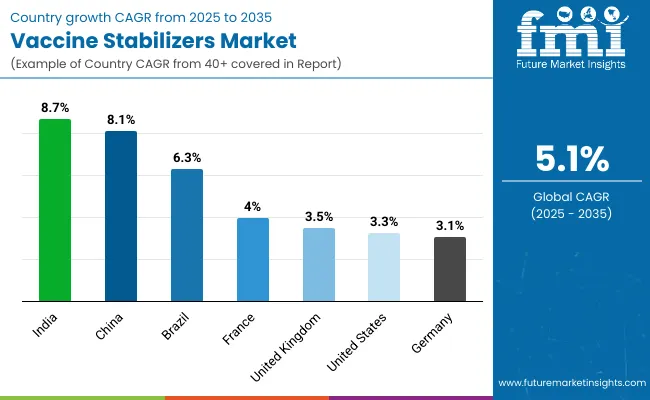
| Country | CAGR (2025 to 2035) |
|---|---|
| India | 8.7% |
| China | 8.1% |
| Brazil | 6.3% |
| United Kingdom | 3.5% |
| United States | 3.3% |
| Germany | 3.1% |
| France | 4.0% |
The vaccine stabilizers market is experiencing robust growth globally, with India leading at a 8.7% CAGR through 2035, driven by the expanding pharmaceutical sector, growing vaccine manufacturing capacity, and increasing investment in healthcare infrastructure across biotechnology industries. China follows at 8.1%, supported by government healthcare initiatives, rising vaccine production capabilities, and increasing focus on pharmaceutical quality in established medical sectors. Brazil shows growth at 6.3%, emphasizing healthcare development and vaccine manufacturing expansion requirements. France records 4.0%, focusing on pharmaceutical excellence and vaccine technology applications. The United States demonstrates 3.3% growth, prioritizing advanced pharmaceutical development and regulatory compliance.
Revenue from vaccine stabilizers in India is projected to exhibit exceptional growth with a CAGR of 8.7% through 2035, driven by the rapidly expanding pharmaceutical sector and increasing vaccine manufacturing programs across healthcare facilities seeking advanced stabilization solutions. The country's growing biotechnology infrastructure and strategic pharmaceutical development are creating substantial demand for high-quality vaccine stabilizers in both traditional and modern pharmaceutical applications. Major pharmaceutical manufacturers and stabilizer suppliers are establishing comprehensive production and distribution capabilities to serve both domestic healthcare requirements and export markets.
Revenue from vaccine stabilizers in China is expanding at a CAGR of 8.1%, supported by government healthcare initiatives, increasing vaccine manufacturing capacity, and growing focus on pharmaceutical innovation requiring advanced stabilizer components. The country's developing pharmaceutical sector and expanding healthcare infrastructure are driving demand for quality stabilizer systems across both traditional and modern pharmaceutical applications. International stabilizer companies and domestic manufacturers are establishing comprehensive distribution and production capabilities to address growing market demand for reliable pharmaceutical excipients.
Revenue from vaccine stabilizers in Brazil is projected to grow at a CAGR of 6.3% through 2035, driven by the country's healthcare development capabilities, vaccine manufacturing requirements, and continued focus on pharmaceutical applications for critical health processes. Brazil's expanding pharmaceutical market and willingness to invest in quality stabilizer systems are creating substantial demand for both standard and specialized stabilizer variants. Leading pharmaceutical companies and healthcare suppliers are establishing comprehensive sourcing strategies to serve both healthcare operations and specialized pharmaceutical markets.
Revenue from vaccine stabilizers in France is projected to grow at a CAGR of 4.0% through 2035, supported by the country's pharmaceutical industry capabilities, vaccine technology requirements, and established tradition of pharmaceutical excellence requiring high-quality stabilizer components. French pharmaceutical organizations' focus on manufacturing quality and proven stabilization performance creates steady demand for reliable stabilizer systems and innovative variants. The country's position as a pharmaceutical leader continues to drive innovation in stabilizer applications and quality standards.
Revenue from vaccine stabilizers in the United Kingdom is projected to grow at a CAGR of 3.5% through 2035, supported by the country's vaccine technology capabilities, expanding pharmaceutical market, and focus on healthcare innovation requiring diverse stabilizer components. British pharmaceutical facilities prioritize manufacturing excellence, regulatory compliance, and pharmaceutical capability enhancement, making vaccine stabilizers essential components for both domestic operations and international pharmaceutical applications. The country's comprehensive pharmaceutical development programs and strategic emphasis support continued stabilizer market development.
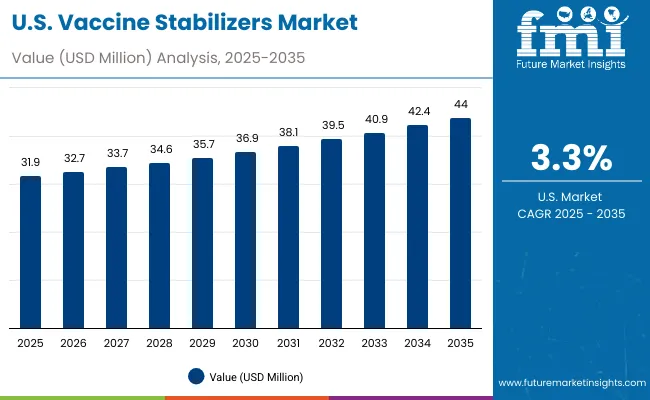
Revenue from vaccine stabilizers in the United States is projected to grow at a CAGR of 3.3% through 2035, driven by the country's pharmaceutical manufacturing capabilities, regulatory compliance requirements, and continued focus on vaccine safety applications for critical healthcare processes. The USA's sophisticated pharmaceutical base and willingness to invest in quality stabilizer systems are creating steady demand for both standard and regulatory-compliant variants. Leading pharmaceutical companies and stabilizer suppliers are establishing comprehensive sourcing strategies to serve both manufacturing operations and specialized pharmaceutical markets.
Revenue from vaccine stabilizers in Germany is projected to grow at a CAGR of 3.1% through 2035, supported by the country's pharmaceutical technology capabilities, vaccine manufacturing sector, and established tradition of engineering excellence requiring high-quality stabilizer components. German pharmaceutical facilities prioritize operational effectiveness, quality reliability, and manufacturing capability enhancement, making vaccine stabilizers essential components for both domestic operations and European pharmaceutical applications. The country's comprehensive pharmaceutical development programs and strategic emphasis support continued stabilizer market development.
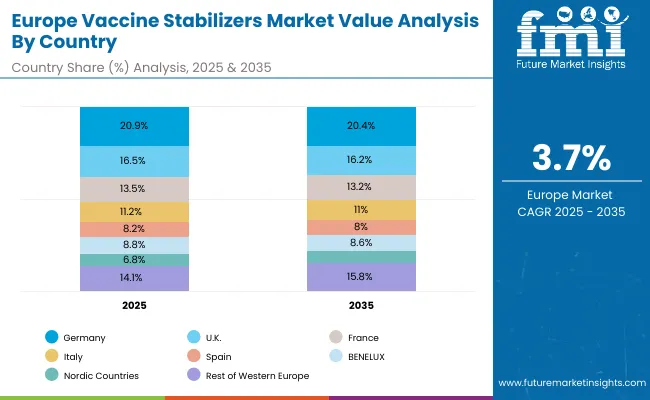
The vaccine stabilizers market in Europe is projected to grow from USD 28.6 million in 2025 to USD 41.4 million by 2035, registering a CAGR of 3.7% over the forecast period. Germany is expected to maintain its leadership position with a 20.9% market share in 2025, declining slightly to 20.4% by 2035, supported by its advanced pharmaceutical sector and vaccine manufacturing capabilities serving European and international markets.
The United Kingdom follows with a 16.5% share in 2025, projected to reach 16.2% by 2035, driven by established vaccine technology expertise and pharmaceutical innovation capabilities. France holds a 13.5% share in 2025, expected to reach 13.2% by 2035, supported by growing pharmaceutical programs and biotechnology development. Italy commands a 11.2% share in 2025, projected to reach 11.0% by 2035, while Spain accounts for 8.2% in 2025, expected to reach 8.0% by 2035.
BENELUX maintains a 8.8% share in 2025, declining to 8.6% by 2035. Nordic Countries hold 6.8% in 2025, declining to 6.7% by 2035. The Rest of Western Europe region, including other Western European nations, is anticipated to hold 14.1% in 2025, growing to 15.8% by 2035, attributed to mixed growth patterns with steady expansion in some markets balanced by slower growth in traditional pharmaceutical countries implementing healthcare modernization programs.
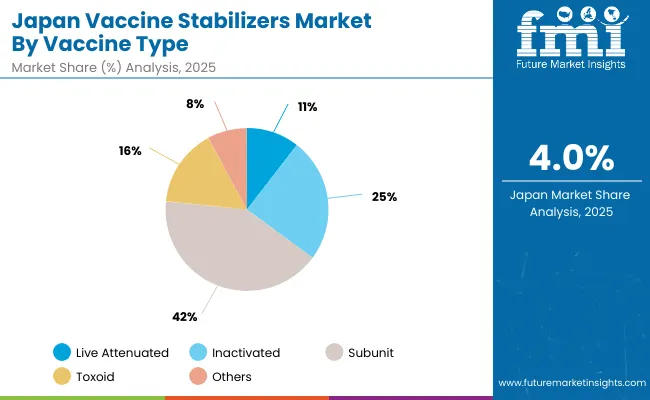
In Japan, vaccine stabilizer demand concentrates in subunit formulations (41.5% share in 2025), supported by rigorous quality standards and cold-chain reliability requirements across national immunization and specialty vaccine programs. Inactivated vaccines (24.6%) remain a sizable use-case, while live attenuated (10.5%) and toxoid (15.5%) portfolios sustain steady stabilizer needs for legacy schedules and booster strategies. Procurement favors proven, biocompatible excipients especially sugars, the leading global class (35.1%) to protect antigen structure during fill-finish and distribution, balancing stability performance with regulatory expectations on purity and consistency.
Market Characteristics
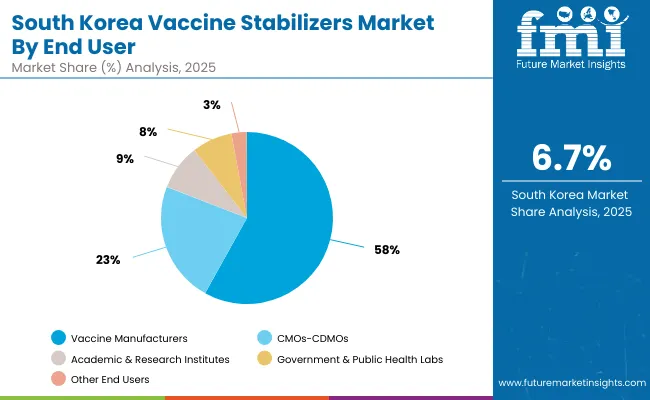
In South Korea, end-user dynamics are manufacturer-centric: vaccine manufacturers account for 58.1% of stabilizer demand, complemented by a strong CMO/CDMO base at 22.8% that supports regional scale-up and export programs. Academic & research institutes (8.6%) and public health labs (7.6%) sustain pipeline development and QA/lot-release functions, while other end users (2.9%) round out niche needs. Formulators prioritize excipient packages led globally by sugars to secure potency through freeze-thaw, transport, and long-haul exports, aligning with Korea’s emphasis on process robustness, cost-efficient scale, and rapid tech-transfer across subunit, inactivated, and other vaccine modalities. Application Insights:
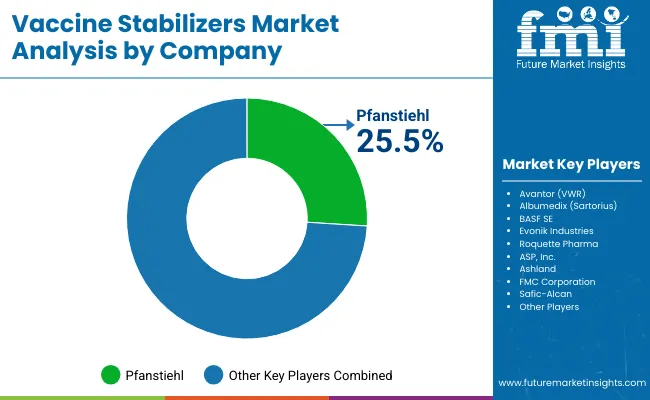
The vaccine stabilizers market is characterized by competition among established pharmaceutical manufacturers, specialized excipient producers, and integrated healthcare suppliers. Companies are investing in advanced stabilization technologies, excipient systems, quality enhancement processes, and comprehensive testing protocols to deliver consistent, high-performance, and regulatory-compliant vaccine stabilizer solutions. Innovation in stabilization efficiency, biocompatible excipients, and specialized applications is central to strengthening market position and pharmaceutical industry confidence.
Pfanstiehl leads the market with a strong focus on excipient innovation and stabilization technology, offering comprehensive stabilization solutions that emphasize purity assurance and regulatory compliance. Avantor (VWR) provides integrated pharmaceutical and stabilizer component capabilities with a focus on advanced research and global distribution networks. Albumedix (Sartorius) delivers precision biotechnology systems with a focus on vaccine excellence and specialized applications.
BASF SE specializes in high-performance chemical solutions with emphasis on excipient quality and critical pharmaceutical applications. Evonik Industries focuses on specialty chemical technology and global market development. Roquette Pharma emphasizes advanced excipient manufacturing with a focus on stabilization applications and quality standardization.
The global vaccine stabilizers market represents a critical component segment within pharmaceutical manufacturing and healthcare, projected to grow from USD 102.3 million in 2025 to USD 168.2 million by 2035 at a CAGR of 5.1%. Subunit vaccines dominate with 41.5% market share, serving primarily sugar-based stabilization applications that demand exceptional stability effectiveness, vaccine integrity, and regulatory compliance. The market's expansion is driven by global vaccine development adoption, pharmaceutical stability requirements, and growing emphasis on vaccine stabilization across critical healthcare applications. Achieving sustained growth requires coordinated efforts across healthcare policy makers, standards organizations, pharmaceutical manufacturers, vaccine integrators, and capital providers.
Pharmaceutical Infrastructure Investment: Establish dedicated pharmaceutical manufacturing zones and biotechnology hubs with specialized facilities for vaccine stabilizer production, including advanced excipient synthesis centers, stability testing laboratories, and skilled workforce training institutes to support domestic stabilizer manufacturing capabilities.
R&D and Innovation Support: Fund research programs focused on advanced stabilization materials, novel excipient technologies, and vaccine stability systems. Support collaborative projects between universities, research institutes, and pharmaceutical manufacturers to develop next-generation vaccine stabilization solutions.
Regulatory Standardization Programs: Invest in regulatory harmonization and standardization programs that develop expertise in pharmaceutical regulations, stability testing, safety assessment techniques, and international compliance standards required for high-quality stabilizer production and approval processes.
Global Immunization Initiative Support: Create incentive schemes for vaccine stabilizer manufacturers, establish health security councils to support international vaccination programs, and negotiate collaborative agreements that enhance global vaccine accessibility and stabilizer supply chain reliability.
Quality Standards & Certification: Develop national pharmaceutical standards aligned with international specifications (FDA, EMA, WHO) and establish accredited testing facilities that enable domestic stabilizer manufacturers to compete in global markets with certified stability and safety credentials.
Technical Standards Development: Establish comprehensive stability standards for vaccine stabilizers covering thermal stability, chemical compatibility, biological safety specifications, and performance criteria that ensure consistent quality across manufacturers and enable reliable product stability evaluations.
Testing and Certification Protocols: Develop standardized testing methodologies for stabilizer performance evaluation including stability effectiveness testing, biocompatibility assessment procedures, shelf life measurement protocols, and quality assurance frameworks that support regulatory approval decisions.
Best Practices Documentation: Create technical guidelines for stabilizer selection, formulation procedures, manufacturing protocols, and regulatory compliance methodologies that help vaccine manufacturers optimize stabilization effectiveness and ensure regulatory compliance across diverse applications.
Professional Certification Programs: Establish technical certification courses for pharmaceutical specialists, formulation scientists, and quality control personnel to ensure industry-wide competency in vaccine stabilizer technology and regulatory expertise.
Market Intelligence & Analytics: Provide regular industry reports covering technology trends, regulatory updates, competitive analysis, and emerging applications to guide strategic planning for manufacturers, suppliers, and end-users across global markets.
| Items | Values |
|---|---|
| Quantitative Units (2025) | USD 102.3 million |
| Vaccine Type | Live Attenuated, Inactivated, Subunit, Toxoid, Others |
| Excipient | Amino acids, Sugars, Polymers, Surfactants, Others |
| End User | Vaccine Manufacturers, CMOs-CDMOs, Academic & Research Institutes, Government & Public Health Labs, Other End Users |
| Regions Covered | North America, Europe, Asia Pacific, Latin America, Middle East and Africa |
| Countries Covered | United States, Brazil, China, India, Germany, France, United Kingdom, Italy, Spain, BENELUX, Nordic Countries, Japan, South Korea and 40+ countries |
| Key Companies Profiled | Pfanstiehl, Avantor (VWR), Albumedix (Sartorius), BASF SE, Evonik Industries, Roquette Pharma, ASP Inc., Ashland, FMC Corporation, Safic-Alcan |
| Additional Attributes | Dollar sales by vaccine type and excipient, regional demand trends, competitive landscape, technological advancements in stabilization, novel excipient integration, regulatory compliance programs, and vaccine stability strategies |
By North America
By Europe
By Asia Pacific
By Latin America
By Middle East & Africa
The global Vaccine Stabilizers market is valued at USD 102.3 billion in 2025.
The size of the Vaccine Stabilizers market is projected to reach USD 168.2 billion by 2035.
The Vaccine Stabilizers market is expected to grow at a 5.1% CAGR between 2025 and 2035.
The key vaccine type segments in the Vaccine Stabilizers market are Live Attenuated, Inactivated, Subunit, Toxoid, and Others.
In terms of vaccine type, the Subunit Vaccines segment is set to command the dominant share in the Vaccine Stabilizers market in 2025.






Our Research Products

The "Full Research Suite" delivers actionable market intel, deep dives on markets or technologies, so clients act faster, cut risk, and unlock growth.

The Leaderboard benchmarks and ranks top vendors, classifying them as Established Leaders, Leading Challengers, or Disruptors & Challengers.

Locates where complements amplify value and substitutes erode it, forecasting net impact by horizon

We deliver granular, decision-grade intel: market sizing, 5-year forecasts, pricing, adoption, usage, revenue, and operational KPIs—plus competitor tracking, regulation, and value chains—across 60 countries broadly.

Spot the shifts before they hit your P&L. We track inflection points, adoption curves, pricing moves, and ecosystem plays to show where demand is heading, why it is changing, and what to do next across high-growth markets and disruptive tech

Real-time reads of user behavior. We track shifting priorities, perceptions of today’s and next-gen services, and provider experience, then pace how fast tech moves from trial to adoption, blending buyer, consumer, and channel inputs with social signals (#WhySwitch, #UX).

Partner with our analyst team to build a custom report designed around your business priorities. From analysing market trends to assessing competitors or crafting bespoke datasets, we tailor insights to your needs.
Supplier Intelligence
Discovery & Profiling
Capacity & Footprint
Performance & Risk
Compliance & Governance
Commercial Readiness
Who Supplies Whom
Scorecards & Shortlists
Playbooks & Docs
Category Intelligence
Definition & Scope
Demand & Use Cases
Cost Drivers
Market Structure
Supply Chain Map
Trade & Policy
Operating Norms
Deliverables
Buyer Intelligence
Account Basics
Spend & Scope
Procurement Model
Vendor Requirements
Terms & Policies
Entry Strategy
Pain Points & Triggers
Outputs
Pricing Analysis
Benchmarks
Trends
Should-Cost
Indexation
Landed Cost
Commercial Terms
Deliverables
Brand Analysis
Positioning & Value Prop
Share & Presence
Customer Evidence
Go-to-Market
Digital & Reputation
Compliance & Trust
KPIs & Gaps
Outputs
Full Research Suite comprises of:
Market outlook & trends analysis
Interviews & case studies
Strategic recommendations
Vendor profiles & capabilities analysis
5-year forecasts
8 regions and 60+ country-level data splits
Market segment data splits
12 months of continuous data updates
DELIVERED AS:
PDF EXCEL ONLINE
Vaccine Preservatives Market Analysis - Size, Share, and Forecast Outlook 2025 to 2035
Vaccine Vial Rubber Stopper Market Size and Share Forecast Outlook 2025 to 2035
Vaccine Transport Carrier Market Size and Share Forecast Outlook 2025 to 2035
Vaccine Shippers Market Size and Share Forecast Outlook 2025 to 2035
Vaccines Market Insights - Trends, Growth & Forecast 2025 to 2035
Vaccine Packaging Market Growth - Demand & Forecast 2024 to 2034
Vaccine Ampoules Market
Dog Vaccine Market Size and Share Forecast Outlook 2025 to 2035
Cat Vaccines Market Size and Share Forecast Outlook 2025 to 2035
Fish Vaccines Market
Live Vaccines Market
Swine Vaccine Market Size and Share Forecast Outlook 2025 to 2035
Covid Vaccine Packaging Market Size and Share Forecast Outlook 2025 to 2035
Market Share Distribution Among Covid Vaccine Packaging Manufacturers
Nasal vaccines Market
Travel Vaccines Market Size and Share Forecast Outlook 2025 to 2035
Cancer Vaccines Market Analysis by Technology, Treatment Method, Application and Region from 2025 to 2035
Dengue Vaccines Analysis by Product Type by Product, By Age Group and by Distribution Channel through 2035
COVID-19 Vaccine Packaging & Delivery Devices Market - Innovations & Trends 2025 to 2035
Covid-19 Vaccine Development Tools Market - Growth & Forecast 2024 to 2034

Thank you!
You will receive an email from our Business Development Manager. Please be sure to check your SPAM/JUNK folder too.
Chat With
MaRIA